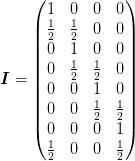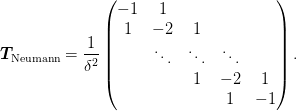mmf.math.multigrid.notes.multigrid_notes¶
| Problem(*varargin, **kwargs) | Representation of the following linear problem for use with a one-dimensional multigrid method. |
| Galerkin | Provides a Galerkin operator A by interpolating and then |
| MultigridBase(*varargin, **kwargs) | Common base for MultigridNeumann and MultigridPeriodic. |
| MultigridPeriodic(*varargin, **kwargs) | Multigrid class for use with Periodic boundary conditions. The interpolation and restriction operators here are: |
| MultigridNeumann(*varargin, **kwargs) | Multigrid class for use with Neumann boundary conditions. The interpolation and restriction operators here are: |
| comparing_periodic() | comparing the various smoothings of periodic |
Inheritance diagram for mmf.math.multigrid.notes.multigrid_notes:

Demo of multigrid features for multigrid.rst.
- class mmf.math.multigrid.notes.multigrid_notes.Problem(*varargin, **kwargs)[source]¶
Bases: mmf.objects.StateVars
Representation of the following linear problem for use with a one-dimensional multigrid method. We provided the following problem:
Problem(a=5, periodic=True, prob=0)
![\begin{aligned}
-f''(x) &= a\pi^2\left[\cos(\pi x)-a\sin^2(\pi x)\right]
e^{a(\cos\pi x -1)}, \\
-f''(x) + a^2\pi^2\sin^2(\pi x)f(x) &=
a\pi^2\cos(\pi x)e^{a(\cos\pi x -1)}, \\
-f''(x) - a\pi^2\cos(\pi x)f(x) &=
-a^2\pi^2\sin^2(\pi x)e^{a(\cos\pi x -1)}, \\
f(x) &= e^{a(\cos\pi x - 1)}.
\end{aligned}](../../../_images/math/9376c60bb19550360cfb1946c6d78598411576e3.png)
This can also be written as a non-linear equation:
![-f''(x) = \pi^2\left[\ln f + a - a^2\sin^2(\pi x)\right]f](../../../_images/math/10dda5e0e14f807d63dc12f4fffb003e465055cc.png)
We may also write this as a set of coupled equations in a few ways, including:
![\begin{aligned}
- f''(x) &= a\pi^2[g - a(1-g^2)]f, \\
- g''(x) &= \pi^2 g = \pi^2 (a^{-1}\ln f + 1)
\end{aligned}](../../../_images/math/e265765c1de6a4ff094e6d63812eac0c3768488c.png)
This gives rise to the following systems for the Jacobian:
![G_3(f, g) = \begin{pmatrix}
- f''(x) - a\pi^2[g - a(1-g^2)]f, \\
- g''(x) - \pi^2 g
\end{pmatrix}, \qquad
J_3 = -\diff[2]{}{x} + \begin{pmatrix}
- a\pi^2[g - a(1-g^2)] & - a\pi^2[1 + 2g]f\\
0 & - \pi^2
\end{pmatrix}.](../../../_images/math/855a7a62a68dcac08e16fdbd30743650feb887b1.png)
![G_4(f, g) = \begin{pmatrix}
- f''(x) - a\pi^2[g - a(1-g^2)]f, \\
- g''(x) - \pi^2 (a^{-1}\ln f + 1)
\end{pmatrix}, \qquad
J_4 = -\diff[2]{}{x} + \begin{pmatrix}
- a\pi^2[g - a(1-g^2)] & - a\pi^2[1 + 2g]f\\
- \pi^2 a^{-1}/f & 0
\end{pmatrix}.](../../../_images/math/3aa0846fdb098a25c214b3eaef98d6c2b0b162a7.png)
Attributes
- class mmf.math.multigrid.notes.multigrid_notes.Galerkin[source]¶
Bases: object
Provides a Galerkin operator A by interpolating and then restricting to the top level. This is not efficient computationally, but can be used to test convergence.
Methods
A(f) Apply the operator Galerkin restriction of the operator A - __init__()¶
x.__init__(...) initializes x; see help(type(x)) for signature
- class mmf.math.multigrid.notes.multigrid_notes.MultigridBase(*varargin, **kwargs)[source]¶
Bases: mmf.objects.StateVars, mmf.math.multigrid.notes.multigrid_notes.Galerkin
Common base for MultigridNeumann and MultigridPeriodic.
MultigridBase(n_0=2, n=7, neutralize=False, smoothing_method=0, n_smooth=[2, 2])
Attributes
- class mmf.math.multigrid.notes.multigrid_notes.MultigridPeriodic(*varargin, **kwargs)[source]¶
Bases: mmf.math.multigrid.notes.multigrid_notes.MultigridBase
Multigrid class for use with Periodic boundary conditions. The interpolation and restriction operators here are:
MultigridPeriodic(n_0=2, n=7, neutralize=False, smoothing_method=0, n_smooth=[2, 2])
The restriction matrix for
 and
and  is
is
The interpolation matrix for
 and
and  is
is
which preserve the Galerkin condition for operators of the form
 (yet to check)
(yet to check)
in the sense that
 has the
same tridiagonal form. In addition, the operator satisfies the
symmetry and charge-neutrality conditions:
has the
same tridiagonal form. In addition, the operator satisfies the
symmetry and charge-neutrality conditions:
One has the following sequence of grid sizes:

Attributes
- class mmf.math.multigrid.notes.multigrid_notes.MultigridNeumann(*varargin, **kwargs)[source]¶
Bases: mmf.math.multigrid.notes.multigrid_notes.MultigridBase
Multigrid class for use with Neumann boundary conditions. The interpolation and restriction operators here are:
MultigridNeumann(n_0=2, n=7, neutralize=False, smoothing_method=0, n_smooth=[2, 2], inclusive=False)

which preserve the Galerkin condition for operators of the form

in the sense that
 has the
same tridiagonal form. In addition, the operator satisfies the
symmetry and charge-neutrality conditions:
has the
same tridiagonal form. In addition, the operator satisfies the
symmetry and charge-neutrality conditions:
One has the following sequence of grid sizes:

Attributes